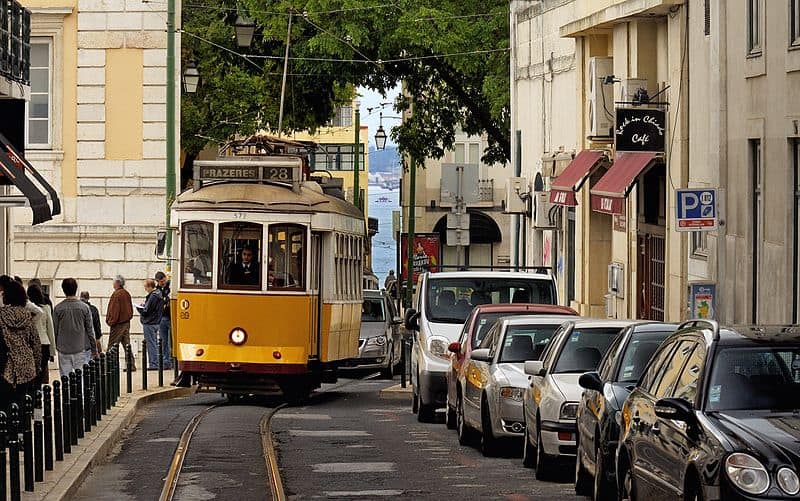Transport in Lisbon: What You Need to Know
I maintain that the best way to get around Lisbon is always by foot. This is a walking city through and through, and with the correct sun hat and comfortable shoes you can lose an entire day on your feet, making your way up and down the sloping street and hillside suburbs.
For lengthier distances or when moving luggage, however, public transport is a welcome savior. Lisbon is well connected and easy to move through. Here’s everything you need to know about getting around.
The Metro in Lisbon
Lisbon’s metro is one of the simplest transportation systems I’ve encountered all my travels. While most metro systems in Europe opt for multiple lines, featuring multiple different trains per line, Lisbon kept it simple and only offers a single train per each route.
The system itself is incredible simple as well; there are only four metro lines that connect the entire city center. There is a red line, a green line, a yellow line and a blue line.

Lisbon Metro – Sourced from the city of Lisbon
Most travelers to Lisbon will encounter the red line as their first mode of transportation between the Lisbon Airport and the center. One can reach the most famous districts like Bairro Alto, Chiado and the Alfama in under 30 minutes using the metro on arrival in the Portuguese capital .
Outlying suburbs and major train stations can also be reached using the interconnected metro system. A metro ride costs €1.50 and tickets can be bought at the issuing machines situated inside each metro station.
One can also purchase multiple rides at discounted rates, 24 hour unlimited rider cards, week long validity cards and others.

Lisbon metro – IngolfBLN – Wikimedia Commons
Taxis and Uber in Lisbon
Ground transportation in Lisbon in the form of taxis and Uber are another popular way of getting from A to B.
Lisbon is one of the most affordable travel destinations in Europe and this extends through to cost of transportation.
Catching a taxi begins with a base fare of anywhere between €2.50 and €4, depending on the company. You then receive a few kilometers of free travel before the €0.70 – €1 per kilometer starts tallying up.

Taxi in Lisbon – by Mika Stetsovski – Wikimedia Commons
Ubers can be ordered via the app from anywhere in the city and the cost of your journey will be give to you prior to confirming your ride.
It is recommended that you have access to Uber if you are expecting to have a late night out on the town. Public transport in Lisbon stops at 1am, and depending on where you are in the city there may not be any taxis lingering around to take you home. Calling an Uber is the most reliable way of getting around late at night.
Tuk-Tuks in Lisbon
Tuk-tuks are like the electric version of free guided walking tours through Lisbon (expect you do have to pay). You’ll see them whizzing through the streets and lingering outside of all of the prominent landmarks in the city center.
The tuk-tuk drivers in Lisbon are unique characters and get excited to take newcomers around the city, sharing their own knowledge along the way.

Tuk-tuks in Lisbon – by Andreas Manessinger – Wikimedia Commons
Most of the Lisbon tuk-tuks operate on a few strict routes which include tours through the Alfama and Belem. There are a few who operate more independently and will customize a journey to your needs.
Expect to pay roughly €10 per person to get around in one of these vehicles.
The Tram in Lisbon
Most people who come to Lisbon are excited to make use of the old school tram system that still connects the city today. The outdated tram cars lurch through the city, picking up riders along the way.
There are some of the most photographed attractions in Lisbon; if you’ve ever seen photographic work of the city, it likely featured a tram and some historic looking buildings behind it.
There are 5 tram lines running through the city. 58 trams live on the lines and operate a collective distance of over 48km.

Lisbon trams – by Ввласенко – Wikimedia Commons
The tram is the best way to get from Lisbon city center into neighborhoods on the west coast such as Belem. The metro doesn’t run this far out and taxis can be expensive.
A single tram journey will cost you €3 and you can purchase your ticket from the driver as you climb on board. If you intend to make your way around the city all day using a tram you’d be better of purchasing the €6 day card that gives you unlimited access. Unfortunately these can only be purchased in any of the Lisbon metro stations and not on the tram itself.
Trains in Lisbon
For everywhere that the metro and tram system can’t get you, there are the Lisbon trains.
Travelers to Lisbon usually keep a day or two reserved for day trips outside of the city center. Areas like Sintra and Cascais are around an hour outside of Lisbon, and offer unique attractions that the city does not; beaches and castles included.
If you imagine landing on the coast of Lisbon, in the south of the city center where you only have the option of heading either further west or further east up the waters edge, this is where the trains come into play.

Lisbon trains – by Threeohsix – Wikimedia Commons
The Santa Apolónia train station will take you up the east and northeastern edge of Lisbon, toward the Lisbon Aquarium and Parque das Nações.
Not far away, the Cais do Sodre train station covers the western landscapes and will stop along all the beach towns en route to Cascais 40 minutes out.

Grey line showing Lisbon trains – Sourced from Lisbon Airport
A train ride out of the main train stations in Lisbon will set you back around €2.50 one way. It is recommended that you purchase your return tickets at the same time to avoid long queues at day end and overcrowding of trains.
When catching a train out of Lisbon be sure to note the last train time if you need to return that same day. Train service usually stops around 9pm in Lisbon; you’ll be left stranded should you miss it.
Planning a trip to Paris ? Get ready !
These are Amazon’s best-selling travel products that you may need for coming to Paris.
Bookstore
- The best travel book : Rick Steves – Paris 2023 – Learn more here
- Fodor’s Paris 2024 – Learn more here
Travel Gear
- Venture Pal Lightweight Backpack – Learn more here
- Samsonite Winfield 2 28″ Luggage – Learn more here
- Swig Savvy’s Stainless Steel Insulated Water Bottle – Learn more here
Check Amazon’s best-seller list for the most popular travel accessories. We sometimes read this list just to find out what new travel products people are buying.










